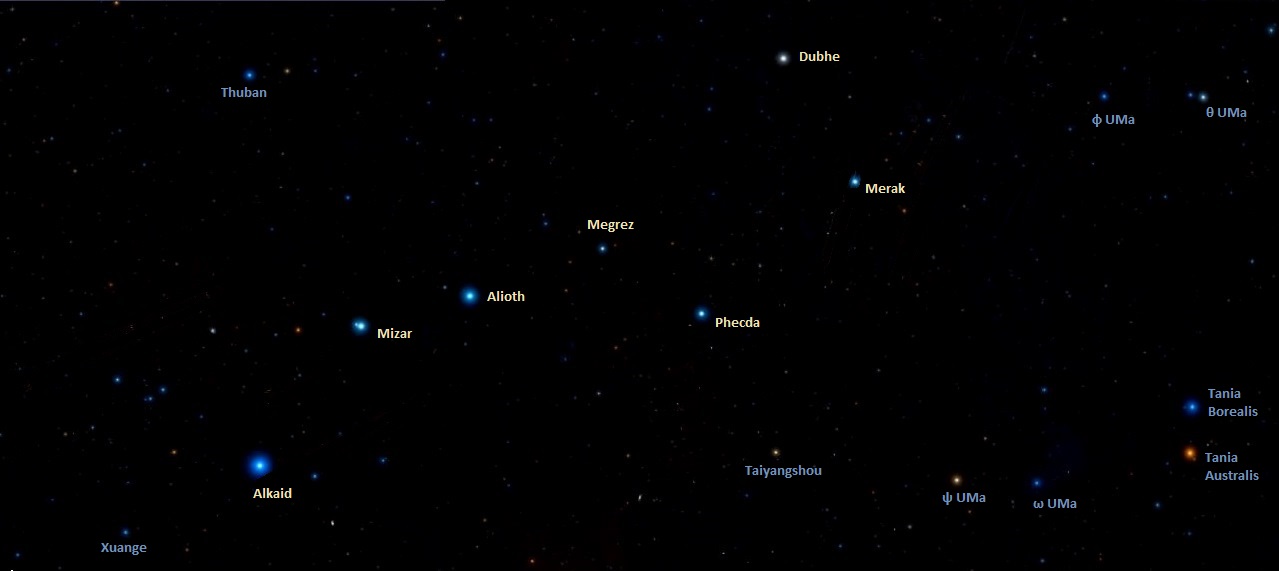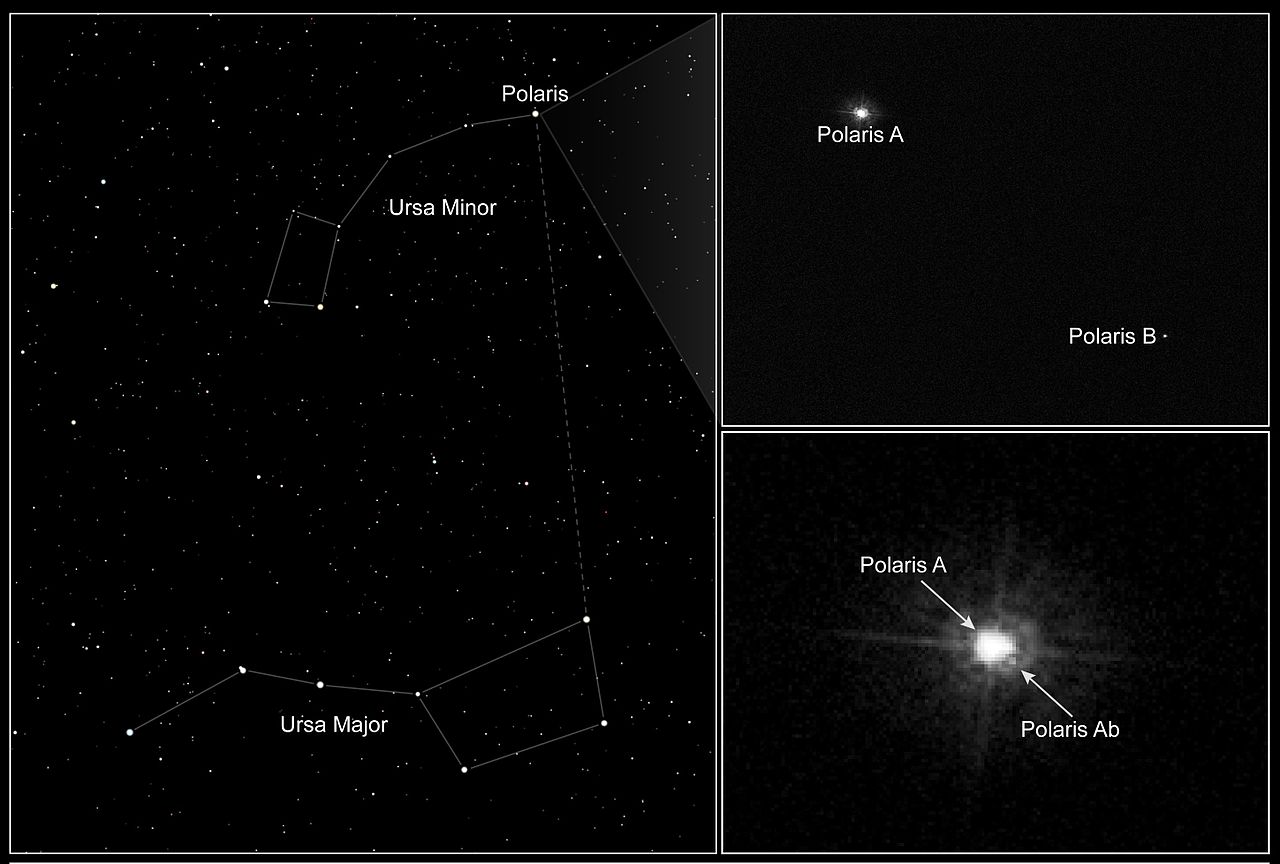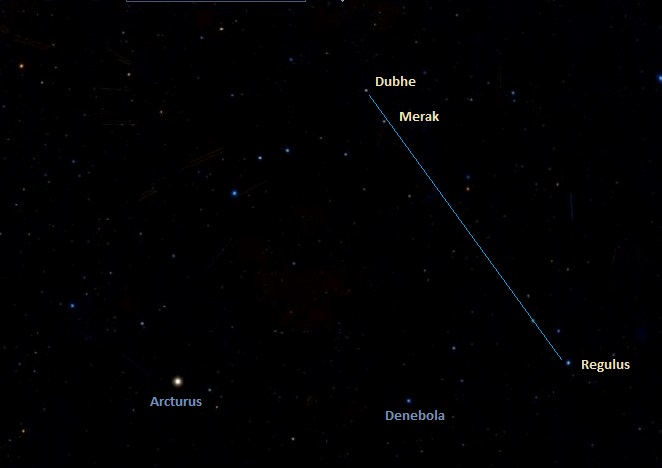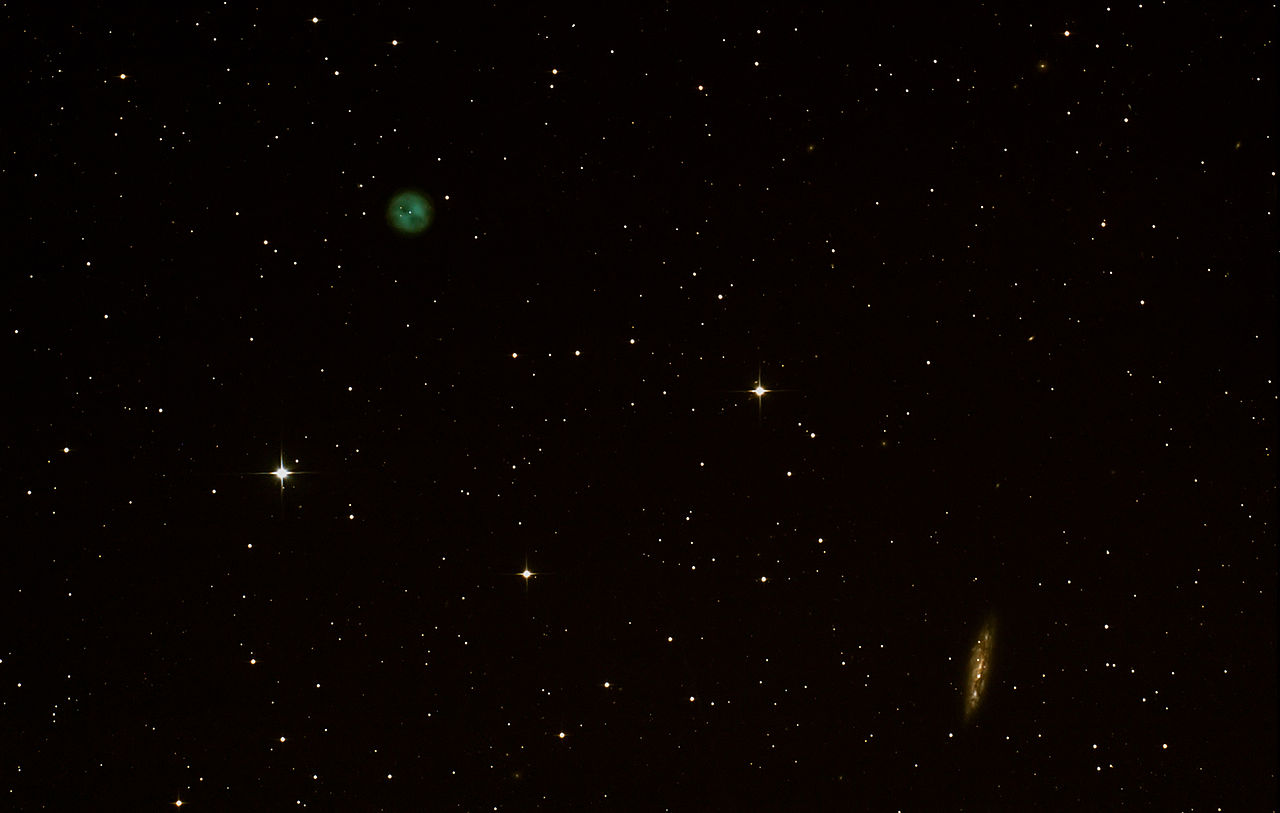Merak, Beta Ursae Majoris (β UMa) is a blue-white subgiant star in the constellation Ursa Major. It is one of the four bright stars that form the bowl of the Big Dipper. With an apparent magnitude of 2.37, it is the fifth brightest star in Ursa Major. It lies at an approximate distance of 79.7 light years from Earth.
Merak outlines the Big Dipper’s bowl and the Great Bear’s hindquarters with the bright stars Dubhe (α UMa), Megrez (δ UMa) and Phecda (γ UMa), while Alioth (ε UMa), Mizar (ζ UMa) and Alkaid (η UMa) form the Dipper’s handle and the Great Bear’s tail. Merak and its neighbour Dubhe are known as the Pointer Stars. The two stars point the way to Polaris and are commonly used to find true north.
Star type
Merak is a bluish-white subgiant star of the spectral type A1IVps. Its estimated age is 500 million years. Having exhausted the hydrogen supply in its core, the star is now in the process of cooling and expanding. Its estimated temperature is about 9,000 K. It has 2.7 solar masses and a radius about three times that of the Sun. It shines with 63 solar luminosities.
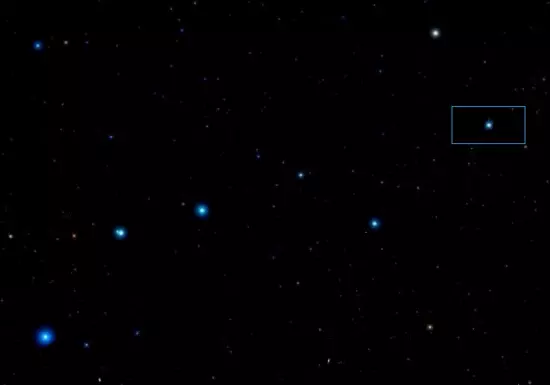
Merak (Beta Ursae Majoris), image: Wikisky
Like Vega in the constellation Lyra and Fomalhaut in Piscis Austrinus, Merak shows an excess emission in the infrared, indicating the presence of a circumstellar debris disk. The dust disk orbits the star at a distance of 47 astronomical units. It has a mass about 27% that of the Earth and a mean temperature of 120 K. No planets have been detected in the disk yet.
Facts
Like its Big Dipper neighbours Phecda, Megrez, Alioth and Mizar, Merak is a member of the Ursa Major Moving Group, a loose stellar association whose members formed in the same molecular cloud and share common velocities and motion through space. In addition to the Ursa Major stars, the members include Menkalinan (Beta Aurigae), Skat (Delta Aquarii), Gamma Leporis, Adhafera (Zeta Leonis), Gamma Microscopii and Beta Serpentis. The Big Dipper stars Alkaid and Dubhe do not belong to the group and, since they are not moving in the same direction as the other five stars, the Big Dipper will dissipate over the course of the next several tens of thousands of years.
In spite of being only the fifth brightest star in Ursa Major, Merak was assigned the designation Beta Ursae Majoris by the German uranographer Johann Bayer, who catalogued the stars in his star atlas Uranometria (1603). While Bayer generally assigned the Greek letters to stars based on their brightness, he was mainly guided by magnitude classes, not the exact order of brightness, because it was not possible to measure stellar brightness accurately in his day. Bayer sometimes also assigned the letters based on the stars’ location within a constellation and this was the case with Ursa Major. He named the constellation’s bright stars from west to east, giving Dubhe, the westernmost (and second brightest) star the designation Alpha, while Alkaid, the easternmost (and third brightest) star got the letter Eta. Ursa Major’s brightest star, Alioth, was given the designation Epsilon Ursae Majoris because it lies in the eastern part of the constellation, in the Bear’s tail.
Merak is located in relatively close physical proximity to Phecda (11 light years or 3.4 parsecs) and it is even closer to the star 37 Ursae Majoris (only 5.2 light years or 1.6 parsecs).
In 1943, Merak was catalogued with the stellar classification A1 V (as a hydrogen-fusing dwarf). Once better instruments were introduced, they were able to identify the star as a subgiant and its class was changed to A0 IV. This was eventually corrected to A1 IV.
Pointer Stars
Merak and its brighter Big Dipper neighbour Dubhe are known as the Pointer Stars. Together, the two stars point the way to Polaris, the nearest visible star to the north celestial pole and marker of true north. An imaginary line drawn from Merak through Dubhe and extended by about five times the distance between the two stars leads directly to the North Star. Polaris is the first relatively bright star along the imaginary line.
Going in the opposite direction, a line drawn from Dubhe through Merak points toward the bright Regulus, the luminary of Leo constellation and the faintest of the first magnitude stars. Regulus is easy to find because it is located at the base of the Sickle of Leo, a relatively bright asterism that looks like a backwards question mark and outlines the lion’s head.
Name
The name Merak (pronunciation: /ˈmɪəræk/) comes from the Arabic al-maraqq, meaning “the flank” or “the loins.” It is the star’s traditional name and it refers to its position in Ursa Major.
The International Astronomical Union’s (IAU) Working Group on Star Names (WGSN) officially approved the name for the star on June 30, 2016.
The Chinese name for the star is the Second Star of Northern Dipper (北斗二), referring to the asterism of the Northern Dipper, which corresponds to the Big Dipper in western astronomy. The Chinese also know Merak as Tiān Xuán (天璇), which translates into English as the Star of Celestial Rotating Jade.
In Hindu mythology, Merak is known as Pulaha, the son of Brahma and one of the Saptarishi (the Seven Sages).
To ancient Arabic astronomers, the stars of the Big Dipper represented a funeral procession. The bowl stars – Merak, Dubhe, Megrez and Phecda – represented the bier, while the handle stars – Alkaid, Mizar and Alioth – represented mourners.
Location
Merak is the bottom right star of the Big Dipper‘s bowl. Like the rest of Ursa Major constellation, the star is circumpolar to most of the northern hemisphere and can be seen year-round. The best time of year to observe the constellation is during the months of spring, when it is particularly prominent in the evening sky.
Merak and its bright neighbours can be used to find several interesting deep sky objects. The barred spiral galaxy Messier 108 and the planetary nebula Messier 97 (the Owl Nebula) lie along the imaginary line connecting Merak and Phecda, the bottom left star of the Dipper’s bowl. They are considerably closer to Merak. Nicknamed the Surfboard Galaxy for its appearance, M108 is located about 1.5 degrees southeast of Merak and the Owl Nebula can be seen in the same field of view, about 48 arcminutes to the southeast of M108.
Constellation
Merak is located in the constellation Ursa Major, the Great Bear. Ursa Major is the third largest constellation in the sky, after Hydra and Virgo, and the largest of all northern constellations. It contains a great many interesting deep sky objects. In addition to those already mentioned, it is home to the galaxies Messier 81 (Bode’s Galaxy), Messier 82 (the Cigar Galaxy), Messier 101 (the Pinwheel Galaxy) and Messier 109.
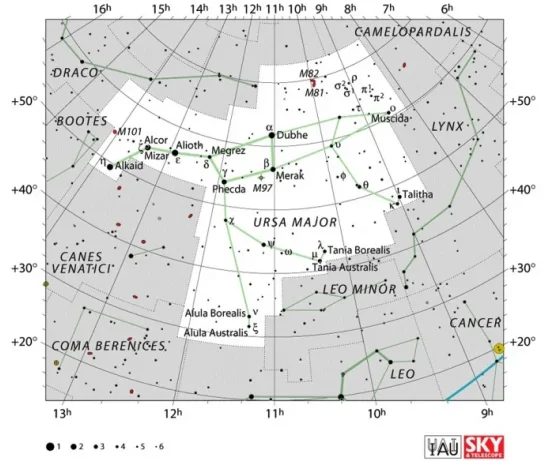
Ursa Major constellation map by IAU and Sky&Telescope magazine
The 10 brightest stars in Ursa Major are Alioth (Epsilon UMa, mag. 1.77), Dubhe (Alpha UMa, mag. 1.79), Alkaid (Eta UMa, mag. 1.86), Mizar (Zeta UMa, mag. 2.04), Merak (Beta UMa, mag. 2.37), Phecda (Gamma UMa, 2.438), Psi Ursae Majoris (mag. 3.01), Tania Australis (Mu UMa, mag. 3.06), Talitha (Iota UMa, mag. 3.14), and Theta Ursae Majoris (mag. 3.166).
Merak – Beta Ursae Majoris
| Spectral class | A1IVps |
| Variable type | suspected |
| U-B colour index | +0.00 |
| B-V colour index | -0.02 |
| Apparent magnitude | 2.37 |
| Absolute magnitude | +0.61 |
| Distance | 79.7 ± 0.3 light years (24.45 ± 0.10 parsecs) |
| Parallax | 40.90 ± 0.16 mas |
| Radial velocity | -12.0 km/s |
| Proper motion | RA: +81.43 mas/yr |
| Dec.: +33.49 mas/yr | |
| Mass | 2.7 M☉ |
| Luminosity | 63.015 ± 1.307 L☉ |
| Radius | 3.021 ± 0.038 R☉ |
| Temperature | 9,377 ± 75 K |
| Age | 500 ± 100 million years |
| Rotational velocity | 46 km/s |
| Surface gravity | 3.83 cgs |
| Constellation | Ursa Major |
| Right ascension | 11h 01m 50.47654s |
| Declination | +56° 22′ 56.7339” |
| Designations | Merak, Beta Ursae Majoris, β UMa, 48 Ursae Majoris, GC 15145, HR 4295, HD 95418, SAO 27876, HIP 53910, FK5 416, BD+57°1302, PPM 32912, Gaia DR2 856096765752993280, TYC 3827-1079-1, GJ 9343, IRAS 10588+5639, 2MASS J11015046+5622566, GCRV 6809 |
